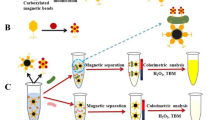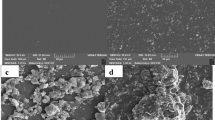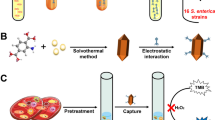Abstract
Yersinia pseudotuberculosis is an enteric bacterium causing yersiniosis in humans. The existing Yersinia pseudotuberculosis detection methods are time-consuming, requiring a sample pretreatment step, and are unable to discriminate live/dead cells. The current work reports a phage-based electrochemical biosensor for rapid and specific detection of Yersinia pseudotuberculosis. The conductive poly(indole-5-carboxylic acid), reduced graphene oxide, and gold nanoparticles are applied for surface modification of the electrode. They possess ultra-high redox stability and retain 97.7% of current response after performing 50 consecutive cycles of cyclic voltammetry.The specific bacteriophages vB_YepM_ZN18 we isolated from hospital sewage water were immobilized on modified electrodes by Au-NH2 bond between gold nanoparticles and phages. The biosensor fabricated with nanomaterials and phages were utilized to detect Yersinia pseudotuberculosis successfully with detection range of 5.30 × 102 to 1.05 × 107 CFU mL−1, detection limit of 3 CFU mL−1, and assay time of 35 min. Moreover, the biosensor can specifically detect live Yersinia pseudotuberculosis without responding to phage-non-host bacteria and dead Yersinia pseudotuberculosis cells. These results suggest that the proposed biosensor is a promising tool for the rapid and selective detection of Yersinia pseudotuberculosis in food, water, and clinical samples.






Similar content being viewed by others
References
Wielkoszynski T, Moghaddam A, Bäckman A, Broden J, Piotrowski R, Mond-Paszek R, Kozarenko A, Ny T, Wilczynska M (2018) Novel diagnostic ELISA test for discrimination between infections with Yersinia enterocolitica and Yersinia pseudotuberculosis. Eur J Clin Microbiol Infect Dis 37:2301–2306. https://doi.org/10.1007/s10096-018-3373-9
Laukkanen R, Martínez PO, Siekkinen KM et al (2008) Transmission of Yersinia pseudotuberculosis in the pork production chain from farm to slaughterhouse. Appl Environ Microbiol 74:5444–5450. https://doi.org/10.1128/AEM.02664-07
Farooq U, Yang Q, Ullah MW, Wang S (2018) Bacterial biosensing : recent advances in phage-based bioassays and biosensors. Biosens Bioelectron 118:204–216. https://doi.org/10.1016/j.bios.2018.07.058
Thoerner P, Bin Kingombe CI, Wassenaar TM et al (2003) PCR detection of virulence genes in Yersinia enterocolitica and Yersinia pseudotuberculosis and investigation of virulence gene distribution. Appl Environ Microbiol 69:1810–1816. https://doi.org/10.1128/AEM.69.3.1810
Fukushima H, Tsunomori Y, Seki R (2003) Duplex real-time SYBR green PCR assays for detection of 17 species of food- or waterborne pathogens in stools. J Clin Microbiol 41:5134–5146. https://doi.org/10.1128/JCM.41.11.5134
Horisaka T, Fujita K, Iwata T, Nakadai A, Okatani AT, Horikita T, Taniguchi T, Honda E, Yokomizo Y, Hayashidani H (2004) Sensitive and specific detection of Yersinia pseudotuberculosis by loop-mediated isothermal amplification. J Clin Microbiol 42:5349–5352. https://doi.org/10.1128/JCM.42.11.5349
Richter Ł, Janczuk-Richter M, Niedziółka-Jönsson J, Paczesny J, Hołyst R (2018) Recent advances in bacteriophage-based methods for bacteria detection. Drug Discov Today 23:448–455. https://doi.org/10.1016/j.drudis.2017.11.007
Savas S, Altintas Z (2019) Graphene quantum dots as nanozymes for electrochemical sensing of yersinia enterocolitica in milk and human serum. Materials (Basel) 12:2189. https://doi.org/10.3390/ma12132189
Sobhan A, Lee J, Park MK, Oh JH (2019) Rapid detection of Yersinia enterocolitica using a single–walled carbon nanotube-based biosensor for Kimchi product. Lwt 108:48–54. https://doi.org/10.1016/j.lwt.2019.03.037
Walper SA, Lasarte Aragonés G, Sapsford KE, Brown CW III, Rowland CE, Breger JC, Medintz IL (2018) Detecting biothreat agents: from current diagnostics to developing sensor technologies. ACS Sensors 3:1894–2024. https://doi.org/10.1021/acssensors.8b00420
Justino CIL, Freitas AC, Pereira R, Duarte AC, Rocha Santos TAP (2015) Recent developments in recognition elements for chemical sensors and biosensors. TrAC - Trends Anal Chem 68:2–17. https://doi.org/10.1016/j.trac.2015.03.006
Singh A, Poshtiban S, Evoy S (2013) Recent advances in bacteriophage based biosensors for food-borne pathogen detection. Sensors (Switzerland) 13:1763–1786. https://doi.org/10.3390/s130201763
Rippa M, Castagna R, Pannico M, Musto P, Borriello G, Paradiso R, Galiero G, Bolletti Censi S, Zhou J, Zyss J, Petti L (2017) Octupolar metastructures for a highly sensitive, rapid, and reproducible phage-based detection of bacterial pathogens by surface-enhanced Raman scattering. ACS Sensors 2:947–954. https://doi.org/10.1021/acssensors.7b00195
Qiu JD, Liang RP, Wang R, Fan LX, Chen YW, Xia XH (2009) A label-free amperometric immunosensor based on biocompatible conductive redox chitosan-ferrocene/gold nanoparticles matrix. Biosens Bioelectron 25:852–857. https://doi.org/10.1016/j.bios.2009.08.048
Dong XX, Yang JY, Luo L, Zhang YF, Mao C, Sun YM, Lei HT, Shen YD, Beier RC, Xu ZL (2017) Portable amperometric immunosensor for histamine detection using Prussian blue-chitosan-gold nanoparticle nanocomposite films. Biosens Bioelectron 98:305–309. https://doi.org/10.1016/j.bios.2017.07.014
Zhang D, Fu L, Liao L, Liu N, Dai B, Zhang C (2012) Preparation, characterization, and application of electrochemically functional graphene nanocomposites by one-step liquid-phase exfoliation of natural flake graphite with methylene blue. Nano Res 5:875–887. https://doi.org/10.1007/s12274-012-0271-9
Kang D, Ricci F, White RJ, Plaxco KW (2016) Survey of redox-active moieties for application in multiplexed electrochemical biosensors. Anal Chem 88:10452–10458. https://doi.org/10.1021/acs.analchem.6b02376
Li X, Xia J, Zhang S (2008) Label-free detection of DNA hybridization based on poly(indole-5-carboxylic acid) conducting polymer. Anal Chim Acta 622:104–110. https://doi.org/10.1016/j.aca.2008.05.044
Zhang W (2016) Poly(indole-5-carboxylic acid)-functionalized ZnO nanocomposite for electrochemical DNA hybridization detection. J Solid State Electrochem 20:499–506. https://doi.org/10.1007/s10008-015-3071-9
Yang T, Ren X, Yang M, Li X, He K, Rao A, Wan Y, Yang H, Wang S, Luo Z (2019) A highly sensitive label-free electrochemical immunosensor based on poly(indole-5-carboxylicacid) with ultra-high redox stability. Biosens Bioelectron 141:111406. https://doi.org/10.1016/j.bios.2019.111406
Zhang T, Chen Y, Huang W, Wang Y, Hu X (2018) A novel AuNPs-doped COFs composite as electrochemical probe for chlorogenic acid detection with enhanced sensitivity and stability. Sensors Actuators B Chem 276:362–369. https://doi.org/10.1016/j.snb.2018.08.132
Santos MA (1991) An improved method for the small scale preparation of bacteriophage DNA based on phage precipitation by zinc chloride. Nucleic Acids Res 19:5442. https://doi.org/10.1093/nar/19.19.5442
Zhou Y, Marar A, Kner P, Ramasamy RP (2017) Charge-directed immobilization of bacteriophage on nanostructured electrode for whole-cell electrochemical biosensors. Anal Chem 89:5734–5741. https://doi.org/10.1021/acs.analchem.6b03751
Schwudke D, Ergin A, Michael K, Volkmar S, Appel B, Knabner D, Konietzny A, Strauch E (2008) Broad-host-range Yersinia phage PY100: genome sequence, proteome analysis of virions, and DNA packaging strategy. J Bacteriol 190:332–342. https://doi.org/10.1128/JB.01402-07
Rashid MH, Revazishvili T, Dean T, Butani A, Verratti K, Bishop-Lilly KA, Sozhamannan S, Sulakvelidze A, Rajanna C (2012) A Yersinia pestis-specific, lytic phage preparation significantly reduces viable Y. pestis on various hard surfaces experimentally contaminated with the bacterium. Bacteriophage 2:168–177. https://doi.org/10.4161/bact.22240
Hu Y, Hu D, Ming S, Duan X, Zhao F, Hou J, Xu J, Jiang F (2016) Synthesis of polyether-bridged bithiophenes and their electrochemical polymerization to electrochromic property. Electrochim Acta 189:64–73. https://doi.org/10.1016/j.electacta.2015.12.091
Ma X, Zhou W, Mo D, Hou J, Xu J (2015) Effect of substituent position on electrodeposition, morphology, and capacitance performance of polyindole bearing a carboxylic group. Electrochim Acta 176:1302–1312. https://doi.org/10.1016/j.electacta.2015.07.148
Liu H, Zhen S, Ming S, Lin K, Gu H, Zhao Y, Li Y, Lu B, Xu J (2016) Furan and pyridinechalcogenodiazole-based π-conjugated systems via a donor-acceptor approach. J Solid State Electrochem 20:2337–2349. https://doi.org/10.1007/s10008-016-3253-0
Gurunathan S, Han JW, Park JH, Kim JH (2014) A green chemistry approach for synthesizing biocompatible gold nanoparticles. Nanoscale Res Lett 9:1–11. https://doi.org/10.1186/1556-276X-9-248
Stankovich S, Dikin DA, Piner RD, Kohlhaas KA, Kleinhammes A, Jia Y, Wu Y, Nguyen SBT, Ruoff RS (2007) Synthesis of graphene-based nanosheets via chemical reduction of exfoliated graphite oxide. Carbon N Y 45:1558–1565. https://doi.org/10.1016/j.carbon.2007.02.034
Zhang J, Yang H, Shen G, Cheng P, Zhang J, Guo S (2010) Reduction of graphene oxide via L-ascorbic acid. Chem Commun 46:1112–1114. https://doi.org/10.1039/B917705A
Godipurge SS, Yallappa S, Biradar NJ, Biradar JS, Dhananjaya BL, Hegde G, Jagadish K, Hegde G (2016) A facile and green strategy for the synthesis of Au, Ag and Au–Ag alloy nanoparticles using aerial parts of R. hypocrateriformis extract and their biological evaluation. Enzym Microb Technol 95:174–184. https://doi.org/10.1016/j.enzmictec.2016.08.006
Li Y, Xie G, Qiu J, Zhou D, Gou D, Tao Y, Li Y, Chen H (2018) A new biosensor based on the recognition of phages and the signal amplification of organic-inorganic hybrid nanoflowers for discriminating and quantitating live pathogenic bacteria in urine. Sensors Actuators B Chem 258:803–812. https://doi.org/10.1016/j.snb.2017.11.155
Richter Ł, Bielec K, Leśniewski A, Łoś M, Paczesny J, Hołyst R (2017) Dense layer of bacteriophages ordered in alternating electric field and immobilized by surface chemical modification as sensing element for bacteria detection. ACS Appl Mater Interfaces 9:19622–19629. https://doi.org/10.1021/acsami.7b03497
Bhardwaj N, Bhardwaj SK, Mehta J, Mohanta GC, Deep A (2016) Bacteriophage immobilized graphene electrodes for impedimetric sensing of bacteria (Staphylococcus arlettae). Anal Biochem 505:18–25. https://doi.org/10.1016/j.ab.2016.04.008
Chauhan N, Narang J, Pundir CS (2011) Immobilization of rat brain acetylcholinesterase on ZnS and poly(indole-5-carboxylic acid) modified Au electrode for detection of organophosphorus insecticides. Biosens Bioelectron 29:82–88. https://doi.org/10.1016/j.bios.2011.07.070
Zhao D, Wang Y, Nie G (2016) Electrochemical immunosensor for the carcinoembryonic antigen based on a nanocomposite consisting of reduced graphene oxide, gold nanoparticles and poly(indole-6-carboxylic acid). Microchim Acta 183:2925–2932. https://doi.org/10.1007/s00604-016-1940-2
Liu X, Li WJ, Li L, Yang Y, Mao LG, Peng Z (2014) A label-free electrochemical immunosensor based on gold nanoparticles for direct detection of atrazine. Sensors Actuators B Chem 191:408–414. https://doi.org/10.1016/j.snb.2013.10.033
Miao X, Li Z, Zhu A, Feng Z, Tian J, Peng X (2016) Ultrasensitive electrochemical detection of protein tyrosine kinase-7 by gold nanoparticles and methylene blue assisted signal amplification. Biosens Bioelectron 83:39–44. https://doi.org/10.1016/j.bios.2016.04.032
Shan C, Yang H, Han D, Zhang Q, Ivaska A, Niu L (2010) Graphene/AuNPs/chitosan nanocomposites film for glucose biosensing. Biosens Bioelectron 25:1070–1074. https://doi.org/10.1016/j.bios.2009.09.024
Yang T, Gao Y, Liu Z, Xu J, Lu L, Yu Y (2017) Three-dimensional gold nanoparticles/prussian blue-poly(3,4-ethylenedioxythiophene) nanocomposite as novel redox matrix for label-free electrochemical immunoassay of carcinoembryonic antigen. Sensors Actuators B Chem 239:76–84. https://doi.org/10.1016/j.snb.2016.08.001
Talbi H, Billaud D, Louarn G, Pron A (2001) In-situ spectroscopic investigations of the redox behavior of poly ( indole-5-carboxylic-acid ) modified electrodes in acidic aqueous solutions. Spectrochim Acta Part A 57:423–433
Han L, Liu P, Petrenko VA, Liu AH (2016) A label-free electrochemical impedance cytosensor based on specific peptide-fused phage selected from landscape phage library. Sci Rep 6:1–10. https://doi.org/10.1038/srep22199
Moghtader F, Congur G, Zareie HM, Erdem A, Piskin E (2016) Impedimetric detection of pathogenic bacteria with bacteriophages using gold nanorod deposited graphite electrodes. RSC Adv 6:97832–97839. https://doi.org/10.1039/C6RA18884B
Zhang X, Xie G, Gou D, Luo P, Yao Y, Chen H (2019) A novel enzyme-free electrochemical biosensor for rapid detection of Pseudomonas aeruginosa based on high catalytic cu-ZrMOF and conductive super P. Biosens Bioelectron 142:111486. https://doi.org/10.1016/j.bios.2019.111486
Bhardwaj J, Devarakonda S, Kumar S, Jang J (2017) Development of a paper-based electrochemical immunosensor using an antibody-single walled carbon nanotubes bio-conjugate modified electrode for label-free detection of foodborne pathogens. Sensors Actuators B Chem 253:115–123. https://doi.org/10.1016/j.snb.2017.06.108
Wang D, Hinkley T, Chen J, Talbert JN, Nugen SR (2019) Phage based electrochemical detection of: Escherichia coli in drinking water using affinity reporter probes. Analyst 144:1345–1352. https://doi.org/10.1039/c8an01850b
Bartlett PN, Dawson DH, Farrington J (1992) Electrochemically polymerised films of 5-carboxyinodele. Preparation and properties. J Chem Soc Faraday Trans 88:2685–2695. https://doi.org/10.1039/FT9928802685
Mahato K, Srivastava A, Chandra P (2017) Paper based diagnostics for personalized health care: emerging technologies and commercial aspects. Biosens Bioelectron 96:246–259. https://doi.org/10.1016/j.bios.2017.05.001
Kageyama T, Ogasawara A, Fukuhara R, Narita Y, Miwa N, Kamanaka Y, Abe M, Kumazaki K, Maeda N, Suzuki J, Gotoh S, Matsubayashi K, Hashimoto C, Kato A, Matsubayashi N (2002) Yersinia pseudotuberculosis infection in breeding monkeys: detection and analysis of strain diversity by PCR. J Med Primatol 31:129–135. https://doi.org/10.1034/j.1600-0684.2002.01034.x
Thisted Lambertz S, Nilsson C, Hallanvuo S (2008) TaqMan-based real-time PCR method for detection of Yersinia pseudotuberculosis in food. Appl Environ Microbiol 74:6465–6469. https://doi.org/10.1128/AEM.01459-08
Matero P, Pasanen T, Laukkanen R et al (2009) Real-time multiplex PCR assay for detection of Yersinia pestis and Yersinia pseudotuberculosis. Apmis 117:34–44. https://doi.org/10.1111/j.1600-0463.2008.00013.x
Zhang H, Feng J, Xue R, du XJ, Lu X, Wang S (2014) Loop-mediated isothermal amplification assays for detecting yersinia pseudotuberculosis in milk powders. J Food Sci 79:967–971. https://doi.org/10.1111/1750-3841.12436
Acknowledgments
This work was supported by the National Key Research and Development Program of China under Grant 2017YFC1104402. The authors also thank the Analytical and Testing Center of Huazhong University of Science and Technology for SEM, EDX, Raman, TEM, and FTIR analyses.
Author information
Authors and Affiliations
Corresponding authors
Ethics declarations
Conflict of interest
The authors declare that they have no conflict of interest.
Additional information
Publisher’s note
Springer Nature remains neutral with regard to jurisdictional claims in published maps and institutional affiliations.
Supplementary information
ESM 1
(DOCX 2172 kb).
Rights and permissions
About this article
Cite this article
Yang, Q., Deng, S., Xu, J. et al. Poly(indole-5-carboxylic acid)/reduced graphene oxide/gold nanoparticles/phage-based electrochemical biosensor for highly specific detection of Yersinia pseudotuberculosis. Microchim Acta 188, 107 (2021). https://doi.org/10.1007/s00604-020-04676-y
Received:
Accepted:
Published:
DOI: https://doi.org/10.1007/s00604-020-04676-y




